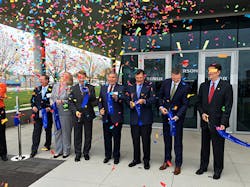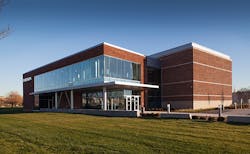Emerson Creates The Helix Innovation Center
When it comes to thinking about the future of HVACR and improving the technologies used in homes, businesses and retail spaces, Emerson is breaking the mold. More specifically, Emerson is breaking out of the traditional ways of thinking with the development of the Emerson Innovation Center.
This new center, called The Helix Innovation Center, represents outside-the-box thinking – on many different levels. Everything about this new 40,000-sq.ft. facility represents a new way of collaboration and problem solving for the Emerson team. Emerson is making a total investment of $35 million in this new innovation center over a five-year period.
The facility will feature multiple HVAC systems to monitor and enhance comfort in multiple real-world environments to test and evaluate building controls and efficiency. The center itself will be a lab for commercial building controls and HVACR technology. There will be collaboration centers, allowing people from across disciplines to gather, discuss, debate and draw out how to improve on comfort and food preservation for customers.
The modules consist of a 2,500-sq.ft. supermarket, a 1,500-sq.ft. commercial kitchen, a fully-functional, two-story, three-bedroom home, the whole facility as a light commercial building, and a 1,000-sq.ft. data center. The ability to actually experience these spaces, evaluate equipment, change refrigerants and walk through HVACR issues that customers experience daily will help to inform their work of solving problems and thinking through solutions.
In addition to the five modules, the facility includes three learning labs. The company plans to host industry meetings and hold forums for HVACR professionals on site, creating a global hub for HVACR learning and education.
The Helix, which opens at the end of April, came about from discussions at Emerson beginning in 2013 around refrigeration issues, but it quickly grew into something bigger.
“Some of us were talking about the need to look at problems that we faced from a systems point of view. It started with refrigeration, but quickly changed to air conditioning systems as well,” says Rajan Rajendran of Emerson Climate Technologies, who leads The Helix.
What we wanted to do was have a place where we could actually collaborate and innovate solutions on the problems we are faced with in our industry and to do it in a different way,—Rajan Rajendran
“What we wanted to do was have a place where we could actually collaborate and innovate solutions on the problems we are faced with in our industry and to do it in a different way,” Rajendran says. “And to involve not only Emerson people but non-Emerson people, and not just in our industry but outside our industry as well.”
As the team thought through what would go into such a center, they realized it had to have a systems approach rather than focusing on individual components. When they took into account that a “system” is not just the HVACR hardware and components, but the entire space, whether a home, commercial building or any other space where heating, air conditioning or refrigeration was necessary, it was clear that this new center had to replicate the environments where the individual HVACR components were being used.
That this new innovation center sits on the campus of the University of Dayton 40 miles away from Emerson Climate Technologies’ headquarters in Sidney, Ohio, is significant.
“We wanted physical separation between our existing facility and this new innovation center,” Rajendran says. “This is not just a building. We are promoting the idea within Emerson of this being a different way of thinking. Not only is this building away from the main Emerson campus, but the building should inspire our people to think about innovation in a different way.”
This is not just a building. We are promoting the idea within Emerson of this being a different way of thinking,—Rajan Rajendran
Rajendran says Emerson wanted to build the new center on a university campus and looked at a number of potential sites to build the innovation center, both around the U.S. and internationally. Among the reasons the University of Dayton was selected was the area’s history of innovation. Rajendran notes the Dayton area was once the Silicon Valley of innovation. In the early 20th century, there were more patents per capita originating from Dayton than anywhere else in the world.
The Helix is a “giant sandbox for us,” says Rajendran. Incorporated into this giant sandbox are a number of smaller sandboxes that include the fully-functioning supermarket, commercial kitchen, a home with fully functioning appliances, and the data center. While these spaces will draw much of the attention, Rajendran points out the spaces that are designed to work through ideas. In fact, 25,000-sq.ft. of space dedicated to collaboration and teaming, which will incorporate white boards and walls on which to write and draw.
Being able to develop these ideas and then walk through a real-world environment to see how it could play out represents a huge advantage for these teams.
“We want to find innovative ways to solve problems that our customers face in human comfort and food preservation. Whatever that means is now in our purview. We’re not really drawing any boundaries on what we can and cannot do here,” Rajendran says. While The Helix is not designed to replace Emerson’s research and development labs or testing centers, ideas created here may eventually lead to future products.
We want to find innovative ways to solve problems that our customers face in human comfort and food preservation,—Rajan Rajendran
The systems and equipment that heat and cool each of the modules within The Helix will be a mix of Emerson and non-Emerson equipment, Rajendran says. All of the products are products that an average homeowner, business or restaurant would use on an everyday basis. Someone asked Rajendran why the home within The Helix was not built as a net-zero home.
“Who has a net-zero home?” Rajendran says. “We all have average homes, so our goal is to see how we can make our average homes more comfortable and energy efficient for you. This is not a showcase for Emerson products.”
The fully-functional home will include ambient temperature control to simulate seasons and climate, allowing teams to research how different air conditioning heating and cooling systems and configurations affect all aspects of human comfort – from temperature, humidity, IAQ and noise.
The supermarket within The Helix includes refrigerated cases, dry goods shelving and integrated controls that include lighting and point of sale systems. The commercial kitchen is fully operational, enabling researchers, engineers and designers to tackle challenges related to new refrigerants and food safety. The data center module will expand the ability of Emerson Network Power’s Thermal Management business to deliver more holistic, next generation approaches to controlling the data center environment and managing heat in the most effective way possible.
“Data is something that we do a lot of at the innovation center. How would we know we solved problems if we can’t measure or prove that it’s been solved?” says Rajendran. “We collect an enormous amount of data from the equipment in The Helix.”
Separate meters will measure energy consumption. For easy testing and evaluation, the facility will have visible ductwork and a station where building metrics from electronic monitors and building controls can be easily accessed.
Because The Helix is a place to test ideas and concepts, everything within the modules are changeable. Insulation can be put in or taken out, windows can be replaced and equipment can be switched. “Everything is fair game for us,” he says.
Data is something that we do a lot of at the innovation center. How would we know we solved problems if we can’t measure or prove that it’s been solved?—Rajan Rajendran
On any given day, there maybe 50 to 80 people within the building. True to the center’s mission to innovate and solve problems, they will bring in industry experts, academics and real-world users to provide their input and experiences.
“We recently had a group of facility managers in here. In another workshop, we had some nurses and homeowners in and we were talking to them,” Rajendran says. “We are in problem-discovery mode. We are always hunting and harvesting, always having our eyes, ears and minds open to new opportunities.”
The issues that face the HVACR industry are tremendous. Environmental regulations and energy efficiency standards are constantly evolving, consumer trends are changing even more frequently and the pool of qualified technicians who are coming into the market is shrinking. Rajendran sees The Helix as a way to stay in front of a rapidly-changing landscape.
“Somebody had to do something different,” he says. “As an industry leader that we believe ourselves to be, we said, ‘let’s do it.’”
With The Helix, great ideas can come rapidly and then go to its engineering and development groups to turn them into new products.
“It’s not every day that a company would invest in a building like this,” Rajendran says. “That shows clear leadership and the long-term vision that the Emerson leadership has.” While other companies may talk about innovation, Emerson Climate Technologies is making it happen.
Michael Maynard is a freelance writer who writes frequently on issues related to HVACR, construction and architecture. He can be reached at [email protected].





